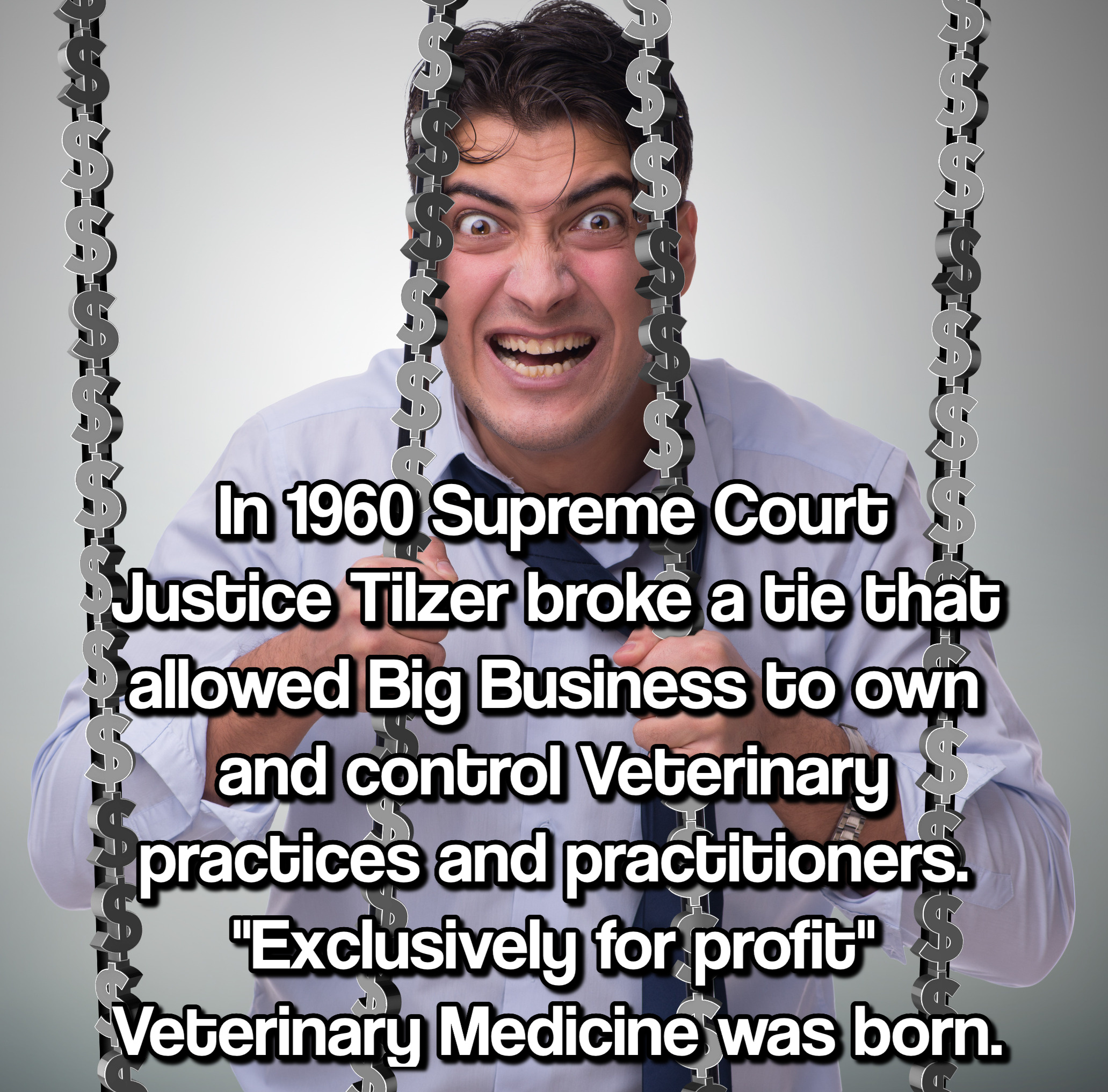
All references and notes here are taken from the articles presented at the end, verbatim with full author’s credit.
The takeover of veterinary practices by non-veterinary owners who are motivated chiefly or solely by profit.
Until 1960 and a single Supreme Court Decision by Justice Tilzer, the US Government felt that doctors in the “learned professions” should be the ones taking the risk, and making the decisions in your health care. From dentistry to ophthalmology, to all forms of medicine and into psychiatry. The US government felt that our health care should be determined by the individual with appropriate education, and not the corporate charter. Then in 1960 that changed and now, anyone can own a medical or veterinary practice and control the decisions made on behalf of the patient.
Under current trends, consolidation of veterinary practices will continue until just three or four companies control 60% or more of the market. Across industries, the number of dominant companies is in the range of three to six, with three or four being the usual. This has to do with the maximum concentration allowed before triggering antitrust litigation. Oligopolies of three or more rivals can still demonstrate to the government that price competition exists*.
*It’s still a crime for individual human doctors to discuss / fix prices between practices in a regional market system.
While the government used to stand fast against the corporate ownership of “learned professions,” today, sure enough, I can buy my pills and my glasses at Walmart. How could this happen?
It happened on the human side: The doctors who wanted to focus on care more than compliance fell into line and now the private medical practice is disappearing, much like the bison in the late 19th century. For better or worse, human medicine has emerged as corporate
But Consolidation and Corporatization Has Touched Most Professions and Industries
I don’t love it that the neighborhood hardware store I used to visit with my dad was razed in 1995 and is now a Home Depot.
And while I hate to admit that I like paying a low price for Tito’s (I try to buy American) and that I enjoy being able to buy any size wrench in the world on a Sunday afternoon, I miss the way it used to be.
But it’s understandable that in the booze and hammer businesses, the big money was destined to bury the little guy.
What’s harder to conceive is that in my hometown, Hamlin’s Drugs and the corner optician are also mere memories. While the government used to stand fast against the corporate ownership of “learned professions,” today, sure enough, I can buy my pills and my glasses at Walmart. How could this happen? At one point I wondered if doctors just weren’t “special” any more. Then came law school—and all of my provincial fantasies were torn asunder.
Consider Justice Tilzer of the New York State Supreme Court
Once I had some training in the law, I discovered why Mr. Hamlin’s drugstore had given way to CVS and Walgreens. And I now know who’s responsible for allowing a candy company to own a monstrous catalog of veterinary hospitals across America. The person responsible is George Tilzer.
You don’t have to read the entire opinion Justice Tilzer wrote in the critical 1960 New York State Supreme Court case—here’s the operative language: “The Court finds that the defendant [Sterling Optical Inc.] is not prohibited from employing licensed optometrists for the limited purpose of examining the eyes of its customers”
And that blew the door open in 1960 for the corporate ownership of the learned professions.
The takeover of veterinary practices by non-veterinary owners who are motivated chiefly or solely by profit.
Of course, we can’t hold the good judge exclusively responsible for the proliferation of corporate dental, veterinary, pharmacy and physical therapy practices across the United States. Similar cases have played out across the country, creating a fertile environment for venture capital to enter the health provision space. And it has. And it’s done very well.
Veterinary medicine isn’t unique in consolidating, of course. In most industries, market structure moves toward fewer businesses with larger shares, as owners aspire to gain economies of size. From a business perspective, this is not a bad thing. The strategy brings owners higher returns on their investments through technological innovation, lower costs and improved efficiency.
For example, consolidators presumably can achieve technical economies of size through improved labor efficiency by eliminating duplicate services in marketing, finance, inventory management and human resource management. In lowering its operating costs by centralizing such services, the company can afford to lower its prices, thereby potentially gaining a larger share of the market.
Consolidators also can save money by purchasing products and services in bulk at discounted per-unit prices and through their greater ability to purchase cutting-edge technology that improves labor efficiency.
Though diminished, independent ownership will not be eliminated, at least not in the near-term. While consolidators focus on small animal private practices, there remain independent rural mixed animal, food animal, equine and community companion animal hospitals.
Corporate veterinary entities are run by boards whose members are some combination of veterinarians, former executives of professional veterinary organizations, Fortune 100 health-care executives, and equity investors. These boards, like those of most corporations, are responsible for managing the CEO, determining operational policies and setting financial performance expectations for the company.
Understanding that the boards have a responsibility to maximize return on investment, the main question for practitioners is: To what extent will this impact veterinary medical service guidelines and veterinarians’ freedom to make the best health-care decisions for their patients?
Veterinarians commonly put medical decisions above financial decisions. At best, these two interests will be put on par under most consolidators‘ roofs.
Hard Facts and Figures on How Fast Corporate Will Consume Veterinary Medicine and How It’s Done.






